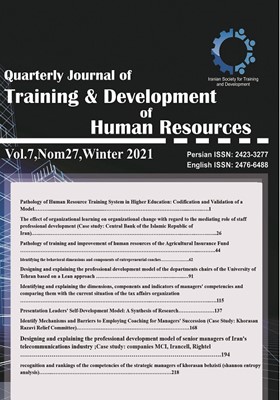Pathology of training and improvement of human resources : The case of the insurance organization
Subject Areas : همسوسازي استراتژي هاي يادگيري و توسعه با استراتژي سازمانTalat Diba Vajari 1 * , Frouz Nouri 2
1 - Payam Nouri
2 - Bu Ali
Keywords: Pathological models Training pathology,
Abstract :
The purpose of this article is to develop the model and identify the damages of training and improvement of human resources and provide improvement programs in the Agricultural Insurance Fund. The research approach is mixed and in this research quantitative and qualitative approaches are used. The method of this study is evaluation. The interview has been used to identify and select indicators. The selection of participants in the interview process was conducted using a targeted sampling method. Structural Interpretation Modeling Software (IMS) was used for weighting the pathology axes. After determining the axes, they were placed in the pathology model of the MTM. After planning and organizing the pathology, an assessment of human resources training and improvement processes was performed and improvement programs for repair or reduction of injuries were determined and using the RPN technique, Prioritized
(1) Wentworth D. Top Spending Trends for Training, 2016-2017. 2017. https://trainingmag.com.
(2) Hamlin, B and Stewart, J (2011) What is HRD? A definitional review and synthesis of the HRD domain, Journal of European Industrial Training, 35 (3), pp 199–220
(3) CIPD (2007) Learning and the Line: The role of line managers in training, learning anddevelopment, CIPD, UK
(4) نوری، فیروز. پیدایی، مهرداد. (1389). آسیبشناسی آموزشی در سازمانها (آموزش و بهسازی در هزار سوم)، انتشارات علم استادان.
(5) فتحی واجارگاه، کورش. نوری، فیروز. (1397). آسيبشناسي آموزش و بهسازي منابع انساني، انتشارات آييژ.
(6) Stracke, Christian M.(2010). Quality Development and Standards in Learning, Education, and Training: Adaptation Model and Guidelines for Implementations. https://www.researchgate.net/publication/228871566
(7) Hill. Rosemary , Stewart. Jim. (2000). Human resource development in small organizations Journal of European Industrial Training.105-117.
(8) Commission of the European Communities (1996), Commission Recommendation of 3 April 1996 concerning the Definitions of Small and Medium-sized Enterprises, Report C(96) 261 final, Brussels.
(9) فتحي واجارگاه، كورش، خراساني، اباصلت، نوري، فيروز و بافنده، حميده، (1392). آسيبشناسي آموزش و بهسازی منابع انسانی شرکت ملی نفت ایران، گزارش پژوهشي.
(10) نوري، فيروز، (1393). آموزش و بهسازی منابع انسانی سازمان تأمین اجتماعی ن. م.ج.ا.ا. و تدوین برنامه توسعه آموزش و بهسازی منابع انسانی، گزارش پژوهشي.
(11) شمس موركاني، غلامرضا. صفايي موحد، سعيد. فاطمي صفت، علي. (1394). آسیبشناسی فعاليتهاي آموزش و بهسازي منابع انساني براساس مدل سه شاخگي، فصلنامه آموزش و توسعه منابع انساني، شماره 7، زمستان 1394 ص 71 .
(12) خراساني، اباصلت، نوري، فيروز و بافنده، حميده. (1394). طراحی نظام جامع آموزش سازمان بازنشستگی کشوري (آسیبشناسی، نیازسنجی و طراحی دورههای تخصصی آموزش)، گزارش پژوهشي.
(13) فتحي واجارگاه، كورش و نوري، فيروز (1394)، آسیبشناسی آموزشی شرکت فولاد هرمزگان مبتنی بر مدل MTM و ارائه راهکارهای بهبود، گزارش پژوهشي.
(14) نوري، فيروز (1395)، آسیبشناسی آموزش نظام ورزش کشور (معاونت برنامهریزی و آموزش وزارت ورزش و جوانان)، گزارش پژوهشي.
(15) طيبي، بهمن. زين العابدين، فلاح. (1396). فصلنامه پژوهش هاي فيزيولوژي و مديريت در ورزش، سال نهم، شماره 2، تابستان 1396 صص 75-83
(16) نوري، فيروز. فتحي واجارگاه، كورش و (1396)، آسیبشناسی آموزش و بهسازی منابع انسانی بانک دی و تدوین برنامه بلند مدت آموزش و توسعه منابع انسانی، گزارش پژوهشي.
(17) فتحي واجارگاه، كورش و نوري، فيروز (1396)، آسیبشناسی آموزش و بهسازی منابع انسانی شهرداري كرج ، گزارش پژوهشي.
(18) سلطاني، محمد رضا، نيكوكار، غلامحسين، پاشايي هولاسو ، امين، خليلي، احمدرضا. آسیبشناسی آموزشهاي سازماني در يكي از مراكز نظامي نيروهاي مسلح با استفاده از الگوي «FPSS»، مجله مديريت فرهنگ سازماني، شماره 48، تابستان 1397، صص 411-438.
(19) زيدوني، زينب (1397). آسيبشناسي نظام آموزش سازمان آب و برق خوزستان، زينب زيدوني، پاياننامه كارشناسي ارشد دانشگاه شهيد چمران اهواز.
(20) Culha. Cagri, Culha. Osman (2010). The effects of organizational training on organizational commitment. International Journal of Training and Development 14:4.
(21) Eisenberger, R., Fasolo, P., & Davis-LaMastro, V. (1990). Perceived organizational support and employee diligence, commitment, and innovation. Journal of Applied Psychology, 75, 51–59.
(22) Schein, E. H. (1996). Culture: The missing concept in organization studies. Administrative Science Quarterly, 41, 229–241.

